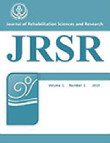Effects of Kinesthetic Imagery, Active and Combined Exercises on the Electromyographic Pattern of Hip Hyperextension and Tests of Relation with Lumbar Hyperlordosis
Mental exercise uses the same neuronal pathways involved in physical exercise to modify the pattern and function without the stress caused by physical exercise. This study investigated the effects of the three methods of kinesthetic imagery, active, and combined exercise (imagery and active) on the pattern of hip hyperextension and the strength of selected muscle of lumbo-pelvic in women with lumbar hyperlordosis.
In this semi-experimental study, 36 women with lumbar hyperlordosis (age: 34.47±3.79, height: 160.48±12.63, weight: 64.46±18.26) were sorted into three groups. The groups practiced three sessions per week for six weeks. The degree of lumbar lordosis using flexible ruler, electromyographic activity of the lumbo-pelvic muscles during hip hyperextension in the prone position using surface electromyogram, the strength of the gluteus maximus during hip hyperextention using dynamometer, the strength of abdominal muscles during lowering two legs test using goniometer, flexibility of hip flexor muscles during the Thomas test using goniometer, and flexibility of erector spine muscles during the Schober test using a meter were measured before and after the intervention. The Shapiro-Wilk test was used for normality of data, and the repeated measures variance test was used for the statistical analysis of data at a significance level of 0.05.
The results showed a significant difference between the three methods of kinesthetic imagery, active and combined (p-value = 0.001). There was a significant difference between the method of imagery exercise and the methods of active and combined exercise, but no significant difference was observed between the methods of active and combined exercise.
Imagery exercises were effective in modifying the electromyographic activity of some lumbo-pelvic muscles (gluteus maximus and rectus femoris muscles); however, they did not have a significant effect on the strength, flexibility, or degree of lumbar lordosis. Combined exercise was as effective as active exercise in modifying the electromyographic activity of the lumbo-pelvic muscles, the strength of the abdominal and gluteus maximus muscles, and the flexibility of erector spine and hip flexor muscles.
- حق عضویت دریافتی صرف حمایت از نشریات عضو و نگهداری، تکمیل و توسعه مگیران میشود.
- پرداخت حق اشتراک و دانلود مقالات اجازه بازنشر آن در سایر رسانههای چاپی و دیجیتال را به کاربر نمیدهد.


